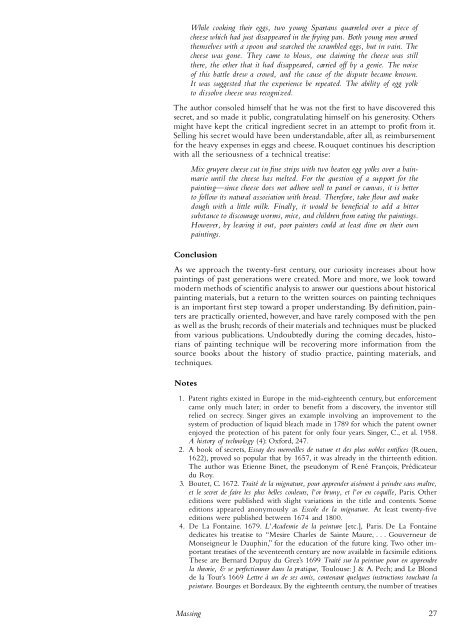Historical Painting Techniques, Materials, and Studio Practice
Create successful ePaper yourself
Turn your PDF publications into a flip-book with our unique Google optimized e-Paper software.
While cooking their eggs, two young Spartans quarreled over a piece if<br />
cheese which had just disappeared in the frying pan. Both young men armed<br />
themselves with a spoon <strong>and</strong> searched the scrambled eggs, but in vain. The<br />
cheese was gone. They came to blows, one claiming the cheese was still<br />
there, the other that it had disappeared, carried off by a genie. The noise<br />
if this battle drew a crowd, <strong>and</strong> the cause if the dispute became known.<br />
It was suggested that the experience be repeated. The ability if egg yolk<br />
to dissolve cheese was recognized.<br />
The author consoled himself that he was not the first to have discovered this<br />
secret, <strong>and</strong> so made it public, congratulating himself on his generosity. Others<br />
might have kept the critical ingredient secret in an attempt to profit from it.<br />
Selling his secret would have been underst<strong>and</strong>able, after all, as reimbursement<br />
fo r the heavy expenses in eggs <strong>and</strong> cheese. Rouquet continues his description<br />
with all the seriousness of a technical treatise:<br />
Mix gruyere cheese cut in f ine strips with two beaten egg yolks over a bainmarie<br />
until the cheese has melted. For the question of a support fo r the<br />
paintinsince cheese does not adhere well to panel or canvas, it is better<br />
to follow its natural association with bread. Therifore, take flour <strong>and</strong> make<br />
dough with a little milk. Finally, it would be bemificial to add a bitter<br />
substance to discourage worms, mice, <strong>and</strong> children from eating the paintings.<br />
However, by leaving it out, poor painters could at least dine on their own<br />
paintings.<br />
Conclusion<br />
As we approach the twenty-first century, our curiosity increases about how<br />
paintings of past generations were created. More <strong>and</strong> more, we look toward<br />
modern methods of scientific analysis to answer our questions about historical<br />
painting materials, but a return to the written sources on painting techniques<br />
is an important first step toward a proper underst<strong>and</strong>ing. By definition, painters<br />
are practically oriented, however, <strong>and</strong> have rarely composed with the pen<br />
as well as the brush; records of their materials <strong>and</strong> techniques must be plucked<br />
from various publications. Undoubtedly during the coming decades, historians<br />
of painting technique will be recovering more information from the<br />
source books about the history of studio practice, painting materials, <strong>and</strong><br />
techniques.<br />
Notes<br />
1. Patent rights existed in Europe in the mid-eighteenth century, but enforcement<br />
came only much later; in order to benefit from a discovery, the inventor still<br />
relied on secrecy. Singer gives an example involving an improvement to the<br />
system of production of liquid bleach made in 1789 fo r which the patent owner<br />
enjoyed the protection of his patent for only four years. Singer, c., et al. 1958.<br />
A history oj technology (4): Oxford, 247.<br />
2. A book of secrets, Essay des merveilles de nature et des plus nobles entifices (Rouen,<br />
1622), proved so popular that by 1657, it was already in the thirteenth edition.<br />
The author was Etienne Binet, the pseudonym of Rene Franyois, Predicateur<br />
du Roy.<br />
3. Boutet, C. 1672. Traite de la mignature, pour apprender aisement a peindre sans martre,<br />
et Ie secret de Ja ire les plus belles couleurs, I'or bruny, et I'or en coquille, Paris. Other<br />
editions were published with slight variations in the title <strong>and</strong> contents. Some<br />
editions appeared anonymously as Escole de la mignature. At least twenty-five<br />
editions were published between 1674 <strong>and</strong> 1800.<br />
4. De La Fontaine. 1679. L'Academie de la peinture [etc.], Paris. De La Fontaine<br />
dedicates his treatise to "Mesire Charles de Sainte Maure, . .. Gouverneur de<br />
Monseigneur Ie Dauphin," for the education of the future king. Two other important<br />
treatises of the seventeenth century are now available in facsimile editions.<br />
These are Bernard Dupuy du Grez's 1699 Traite sur la peinture pour en apprendre<br />
la theorie, & se peifectionner dans la pratique, To ulouse: J & A. Pech; <strong>and</strong> Le Blond<br />
de la Tour's 1669 Lettre a un de ses amis, contenant quelques instructions touchant la<br />
peinture. Bourges et Bordeaux. By the eighteenth century, the number of treatises<br />
Massing 27


